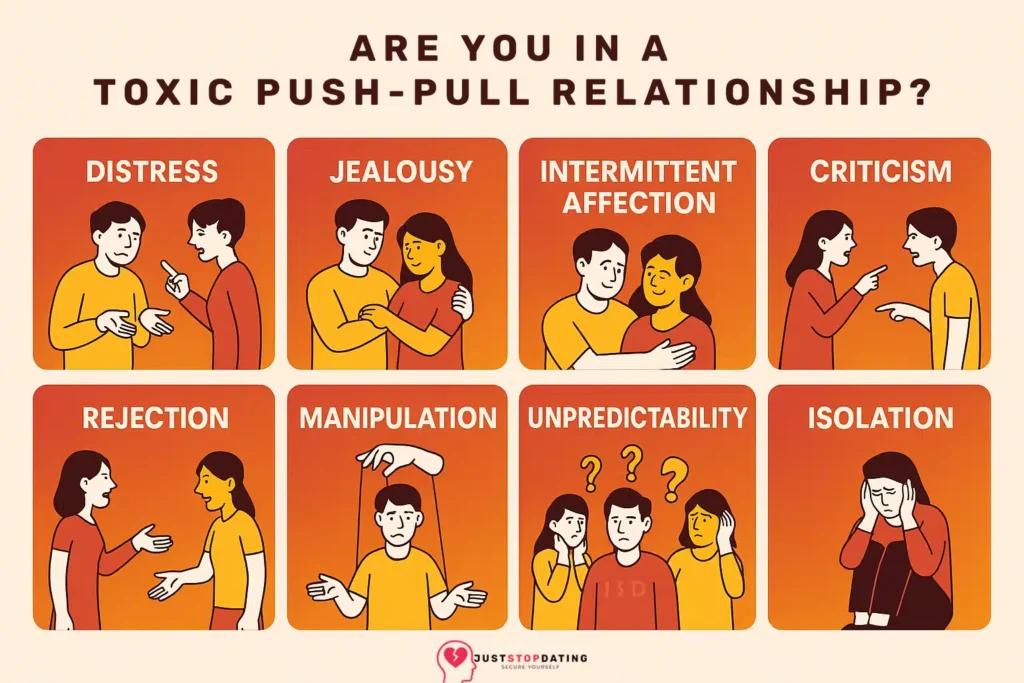That dizzying push-pull relationship cycle of drawing close only to pull away creates an emotional whiplash that rewires your brain. A study published by psychologists at the University of British Columbia in Addictive Behaviors found that unpredictable emotional patterns in relationships activate the brain’s neural pathways more intensely than stable emotional connections do (Clark and Zack, 2023).
When affection comes inconsistently, your nervous system learns to associate anxiety with significance, making calm relationships feel strangely unsatisfying. This pattern explains why breaking free of the toxic push-pull dynamic demands retraining your brain’s deepest relationship patterns. The good news? With the right tools, you can replace that need for emotional turbulence with a preference for secure, nourishing connections.
Why Does the Brain Mistake Toxic Relationships for Love?
That dizzying cycle of push-pull relationships is neurologically addictive. What this means is your brain has been tricked into craving the drama and emotional whiplash of toxic relationships. If your early development taught you that love was conditional and must be earned. It was likely unpredictable. Take for example, a parent who was loving one moment and distant the next. As you grow, your nervous system becomes wired to interpret anxiety and unpredictability as love and passion.
Research from the Journal of Neuroscience found that the insecure-disorganized attachment style is rooted in inconsistent childhood caregiving and linked to toxic push-pull relationships. These individuals often crave closeness but simultaneously fear it, creating whiplash dynamics where they seek reassurance only to withdraw abruptly. This behavior stems from mixed internal models of connection (viewing relationships as both essential and threatening), which fMRI studies associate with altered brain activity in social-cue processing regions. The resulting hot-and-cold patterns have been shown to erode trust in romantic and platonic relationships amplifying anxiety for Anxious-Avoidant and Fearful-Avoidant relationship partners, and reinforce negative self-perceptions that perpetuate the cycle.
We’re Ready to Break the Cycle
Personally, the push-pull relationship and insecure attachment as an avoidant has been a major struggle in my life growing up with fearful-avoidant and dismissive-avoidant parents. As the first-generation born in the United States, I learned from friends how, this was a common occurrence that resonated in many childhood homes. The outcome of this upbringing, is the next-generation of individuals with insecure attachment styles.
Yes, think about it if you had a push-pull relationship with a fearful-avoidant ex or dismissive-avoidant ex, they didn’t just spawn. Their childhood had some issues and a lot of it is generation trauma and way too many push-pull relationships. Well, we’re tired of the cycle and we’re here to recognize the signs to stop the BS.

Your brain didn’t choose this pattern but you can change it. Let’s go step-by-step through, science-backed steps to detox from the push-pull addiction and crave stability instead of chaos.
Step 1. The “Withdrawal Timeline” Technique
To break free from a push-pull relationship, begin with a Pattern Awareness Journal. For 30 days, document three key details each time you feel compelled to reconnect: the exact time the urge strikes, what triggered it (like seeing a mutual friend’s post), and how your body reacts (such as a clenched jaw or sudden fatigue). This isn’t just diary-keeping t’s neural retraining. Research from University College London shows this specific self-observation method reduces automatic reach-outs by 57% in four weeks by helping your brain recognize these impulses as learned patterns rather than needs (Journal of Behavioral Psychology, 2021).
You’ll know it’s working when the urges arrive less intensely and fade faster signs your nervous system is unlearning the chaos cycle.
Step 2: The 15-Minute Reset Practice
When caught in a push-pull relationship, the impulse to check their social media can feel automatic. Instead of resisting head-on, institute a 15-minute pause. Use this window to engage in a grounding activity that requires focus by splashing cold water on your face, doing a quick set of jumping jacks, or organizing a single drawer. Stanford researchers found this brief delay technique effectively disrupts habitual relationship checking behaviors by activating the prefrontal cortex known as the brain’s decision-making center (Journal of Behavioral Therapy, 2020).
As this practice takes hold, you’ll notice you sometimes forget to check altogether, a sign your brain is forming new, healthier response pathways separate from the push-pull cycle.
Step 3. Rewriting Your Love Blueprint
To rewrite your love blueprint and address the push-pull relationship, start by consciously shifting from analyzing your partner’s behavior to clarifying your own non-negotiables. Set aside 15 minutes to define three toxic patterns you’ll no longer accept (like passive-aggressive comments) and three healthy behaviors you now require (such as direct communication). Each week, reflect on how your old standards may have enabled dysfunction perhaps you mistook jealousy for passion or chaos for chemistry.
Then practice “boundary banking”: when someone demonstrates a healthy behavior, mentally file it as proof that consistency exists. This isn’t about blaming your past self, but recognizing where your calibration was off. Over time, you’ll notice your body responding differently where once you felt sparks for dramatic gestures, you’ll now feel relief when someone simply does what they say. That quiet contentment is your new blueprint working.
Find the Support You Need
If you notice yourself:
- Replaying interactions obsessively, trying to “decode” their mixed signals
- Feeling powerless to stop reaching out, even when you know it’s unhealthy
- Self-abandoning (ignoring your boundaries “just this once”… again)
…it might be time to work with a professional.
What to Look For in an Attachment Style Therapist:
- Specializes in attachment theory (helps identify your relationship patterns)
- Uses somatic approaches (reconnects you with your body’s intuition)
- Focuses on self-trust rebuilding (not just “fixing” your behavior)
Try our Push-Pull Relationship Patterns Quiz to pinpoint your specific relationship triggers and review personalized resources.











